The Brendan Voyage
- Post author By Simon King
- Post date July 24, 2020
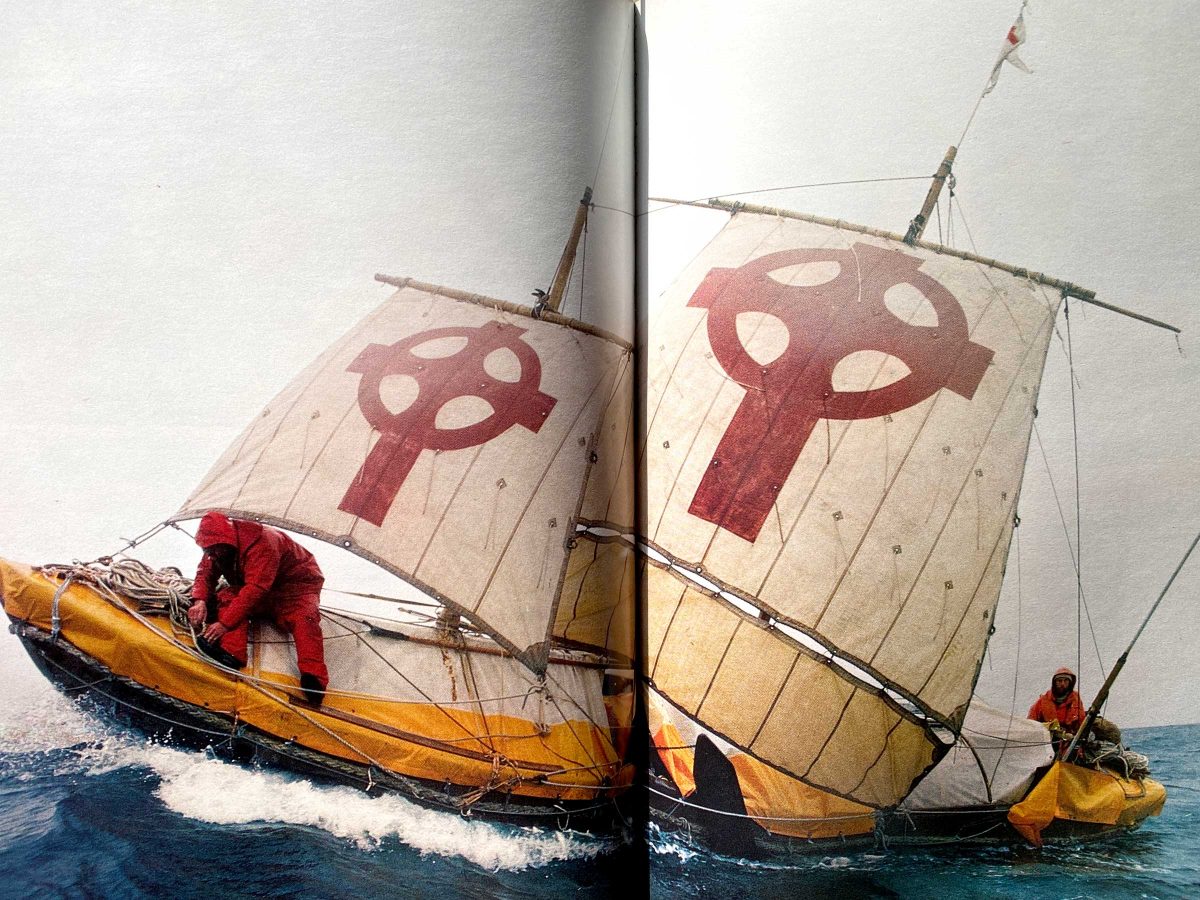
You could say that Tim Severin is a historical re-enactor, but that would conjure all the wrong images, of renaissance fairs and Colonial Williamsburg. At nearly 80 years old, his accomplishments are better described as experiential archaeology , recreating legendary journeys to prove they could have happened. His historical adventures are based on years of upfront study, working with scholars to decipher ancient texts and find period-appropriate technology and materials. I only recently learned about Severin’s work, through his 1978 book that documents a fascinating early project called The Brendan Voyage .
In the 6th-century, an Irish monk named St. Brendan wrote the Navigatio Sancti Brendani Abbatis (The Voyage of St. Brendan the Abbot), a document describing a westward sea journey to the “promised land” that some believe was North America. The journey included numerous stops at islands along the way, and he described seeing fantastic sights and creatures from aboard his medieval “skin boat.” Although some scholars interpret the monk’s manuscript figuratively, others subscribe to the belief that it is more travelogue than fable. That question is at the heart of The Brendan Voyage , Severin’s project to recreate St. Brendan’s journey and prove that a leather-clad sailboat could successfully traverse the North Atlantic.
“Of course, if the claim was true, then Saint Brendan would have reached America almost a thousand years before Columbus and four hundred years before the Vikings.” The Brendan Voyage by Tim Severin, Chapter 1
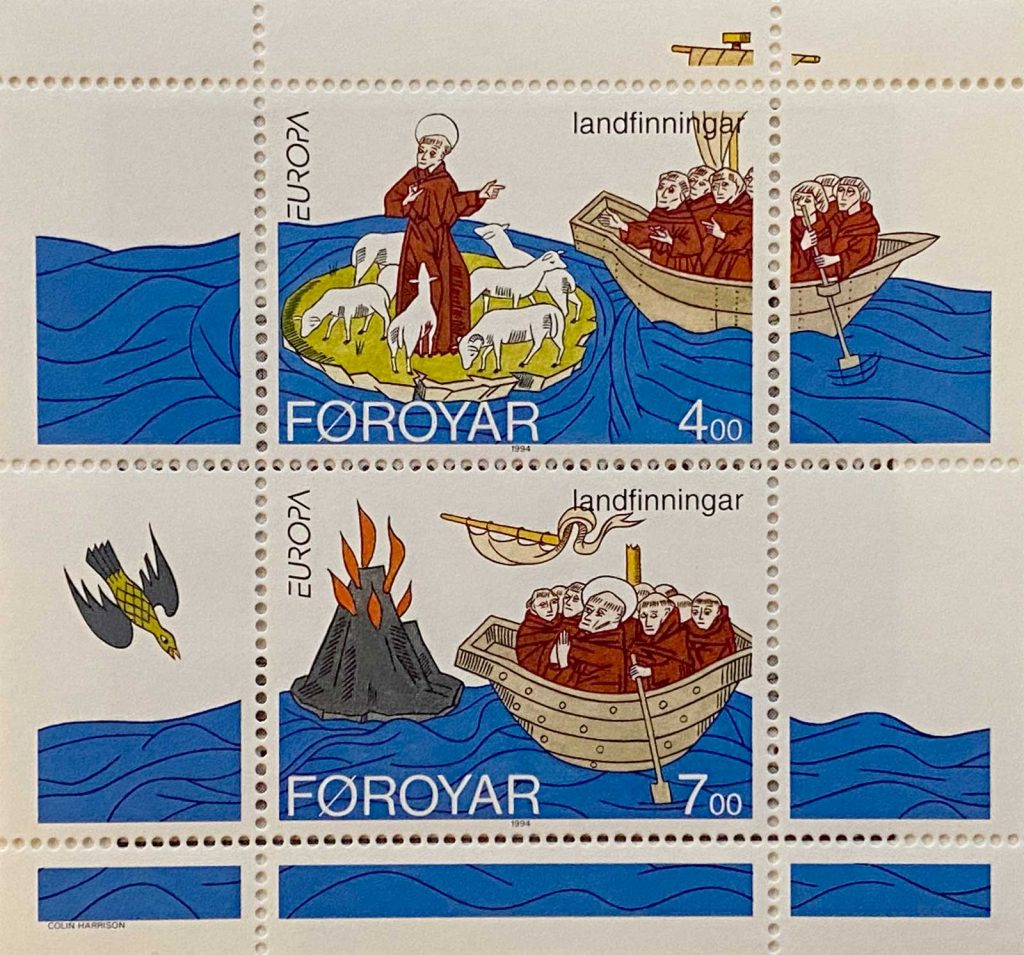
Severin’s first task, which took years of hard work, was the creation of a boat that would match the one used by St. Brendan. In The Brendan Voyage he describes a process of researching, learning, and collaborating with various experts. The energy surrounding the project is contagious, and propelled by what he calls “Brendan Luck” that seems to grace him throughout the project.
The traditional Irish curragh , which is still in use today on the west coast of Ireland, is a descendent of the boat that St. Brendan would have sailed. In modern times, canvas is stretched over the wooden frame, but the Navigatio describes a boat covered with oxhide. This was the first materials challenge for Severin, and initial tests showed that leather would deteriorate quickly in sea water.
Luckily the text provides additional clues, describing the leather as “tanned in oak bark” and coated in “grease” to make it water proof. After numerous lab studies it was proven that, indeed, oak bark was the best leather treatment. Severin found a single tannery in Britain that could help, run by the Croggon family in the Cornish town of Grampound. They had been using traditional tanning techniques since they opened in 1711, and as Brendan Luck would have it, they were enthusiastic about the project.
“So began a delightful period of work. The British leather industry took the Brendan project to heart, and what splendid people the leathermakers turned out to be.” The Brendan Voyage by Tim Severin, Chapter 2
The manuscript describes applying “grease” to the leather, and even mentions bringing extra grease on the journey for re-application. These kinds of details further convinced Severin that he was reading the documentation of a real trip. It’s easy to determine that this must have been lanolin or “wool grease,” a wax that secreted by sheep. Severin and his crew applied it liberally to the oak bark leather and described the resulting stench as nearly unbearable.
“I wonder if you could supply me with some wool grease.” “Yes, of course. How much do you want?” “About three-quarters of a ton, please.” There was stunned silence. The Brendan Voyage by Tim Severin, Chapter 2
The remaining challenges of building Brenden , a 36-foot medieval boat were numerous and back breaking. Just the right cuts of oak and ash were found to build the mast and hull—apparently the north side of the tree is the strongest. Joints were lashed together with miles of leather stripping, and 49 overlapping ox hides were stitched together with flax cords. Brendan Luck struck again when Severin learned that John O’Connell, a master harness maker, lived nearby where the boat was being built. He joined the project and taught Severin and a team of volunteers how to stitch the thick leather. Once on the ocean their lives would depend on the quality of every stitch and knot, a reality that hung heavy over the slow and strenuous work.
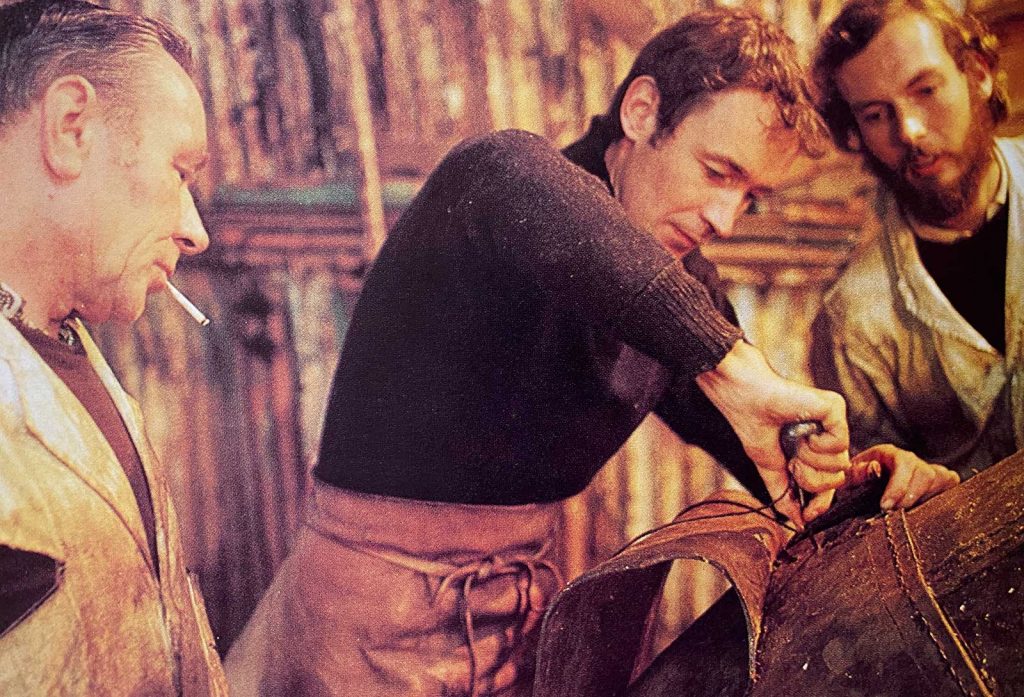
For more detail on the boat’s construction I suggest checking out the article Across the Atlantic in a Leather Boat , which includes relevant excepts from the book and broader information on traditional skin boats in other parts of the world.

The Journey
On May 17, 1976 Brenden set sail from Brandon Creek (named after an alternate spelling of the monk’s name) in County Kerry, Ireland. Every step of the voyage is detailed wonderfully in the book, including photographs from aboard the boat. Even though I knew they would make it, the vivid description of life aboard the boat was both nail biting and riveting.
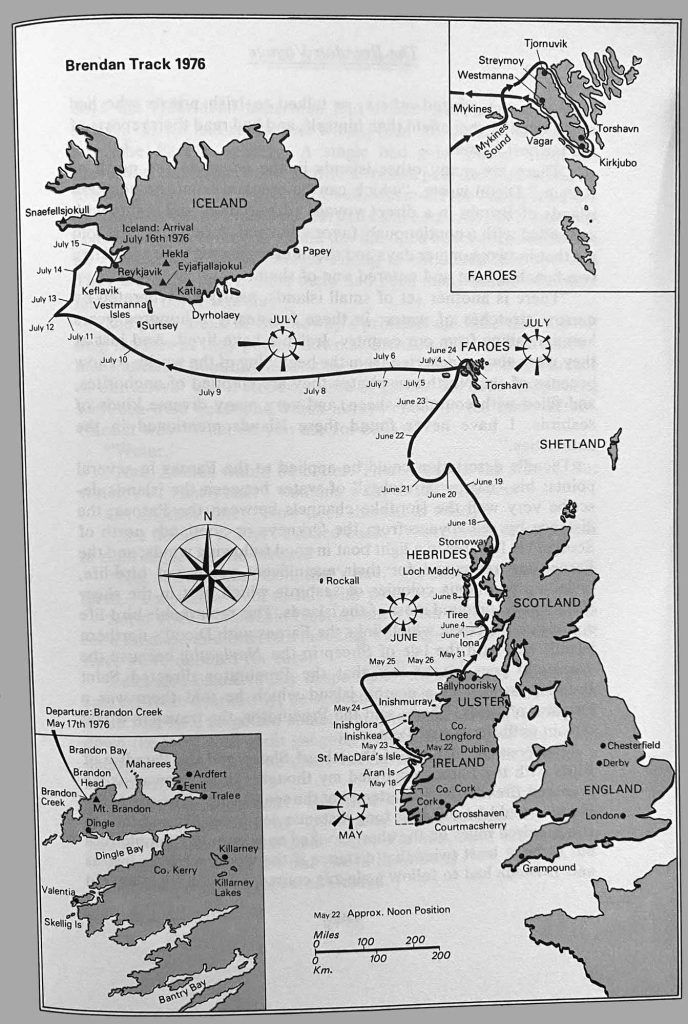
The route, as with the boat’s construction, was an attempt to recreate the original journey as much as possible. Brendan followed a “stepping stone” path along the western coast of Ireland, and into the Outer Hebrides of Scotland. The first long stretch at sea was from Stornoway to the Faroe Islands, and in-between the crew was delighted by continual visits from pods of curious whales.
The Faroes are a potential match for two of the islands mentioned in the Navigatio : “The Island of Sheep” and “The Paradise of Birds.” As they approached the islands from the west, a storm in the Mykines Sound nearly forced Brendan to sail onward without landing, but they managed to maneuver north around Streymoy and land safely in the harbor at Tjørnuvík.
“More than any other people I had ever met, the Faroese understood the sea and showed their appreciation of the endeavor, and once again it was easy to detect the common bond which linked all seafarers in those hostile, northern waters.” The Brendan Voyage by Tim Severin, Chapter 7
Throughout the journey, there were a few points where it became necessary for crew members to leave the project, because of injury or circumstance, and thus new people were needed to join. On the Faroe Islands, Brendan Luck would have it, that Tim Severin met Tróndur Patterson.
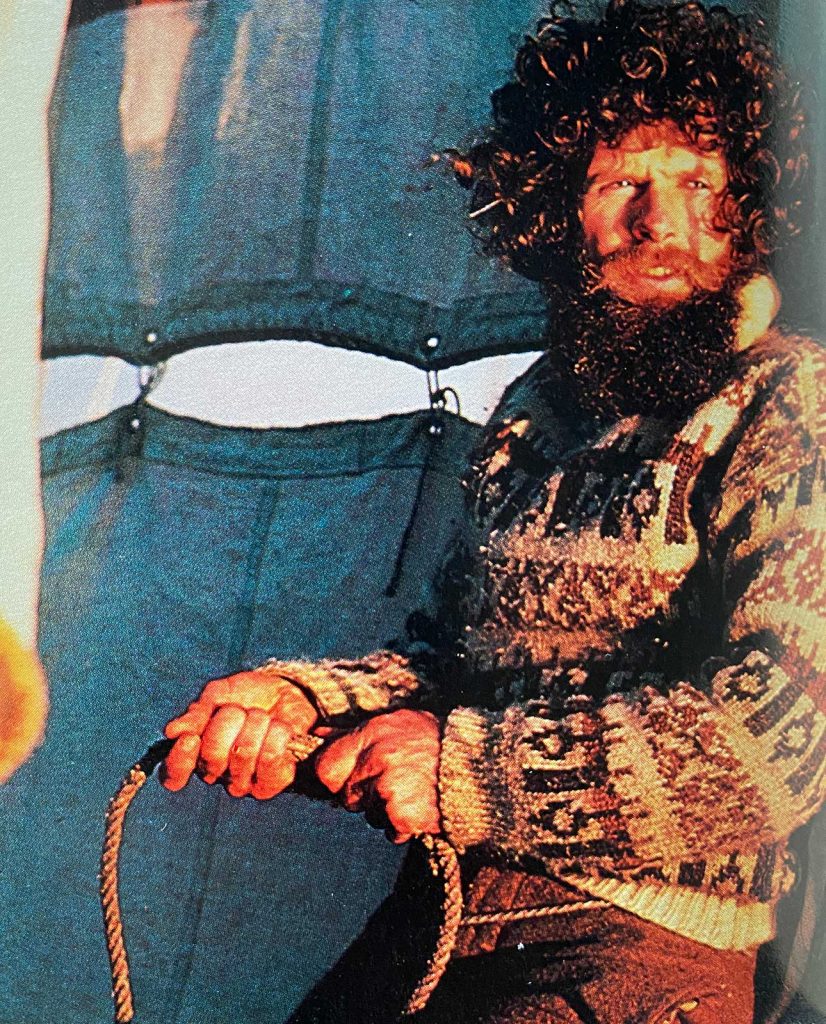
Today, Tróndur Patterson is a well known artist in the Faroe Islands. He’s celebrated for his paintings, sculptures, and glass art that are inspired by life at sea. Severin described meeting Tróndur as an almost fateful occurrence, beginning with an invitation to his home in Kirkjubøur where he realized that the village had a historical place name related to St. Brendan.
“What is the name of the village?” I asked. “Kirkjubo,” she replied. “Does it have any other name?” “Yes, sometimes this place is called Brandarsvik.” The Brendan Voyage by Tim Severin, Chapter 7
Tróndur was quieter than the other crew members, but he brought a Faroese confidence to life at sea. He was adept at catching seabirds using whale blubber, and had tricks for staying warm in soaking wet clothes. He also had a sixth sense for a how to respond in stormy weather, which proved invaluable during the latter half of the trip. His spare time at sea was spent drawing, and the book is filled with his illustrations.
Not only was Patursson a vital crew member on Brendan , the fateful meeting kicked off a longer collaboration with Severin. Just two years after The Brendan Voyage was complete they were reunited aboard another ancient vessel to attempt The Sindbad Voyage .
From the Faroe Islands the crew sailed to Iceland, which St. Brendan called the “Island of Smiths” in an apparent description of a volcanic eruption. After bringing the boat ashore in Reykjavík, it was clear that Brendan had fared well. The leather hull was coated in barnacles, but without a single tear or hole. Still, after weeks of waiting for favorable weather, it was determined that the sea between Iceland and Greenland was simply too rough to continue; sailing season was over. They decided to wait until the following spring and docked Brendan in Iceland for the winter.
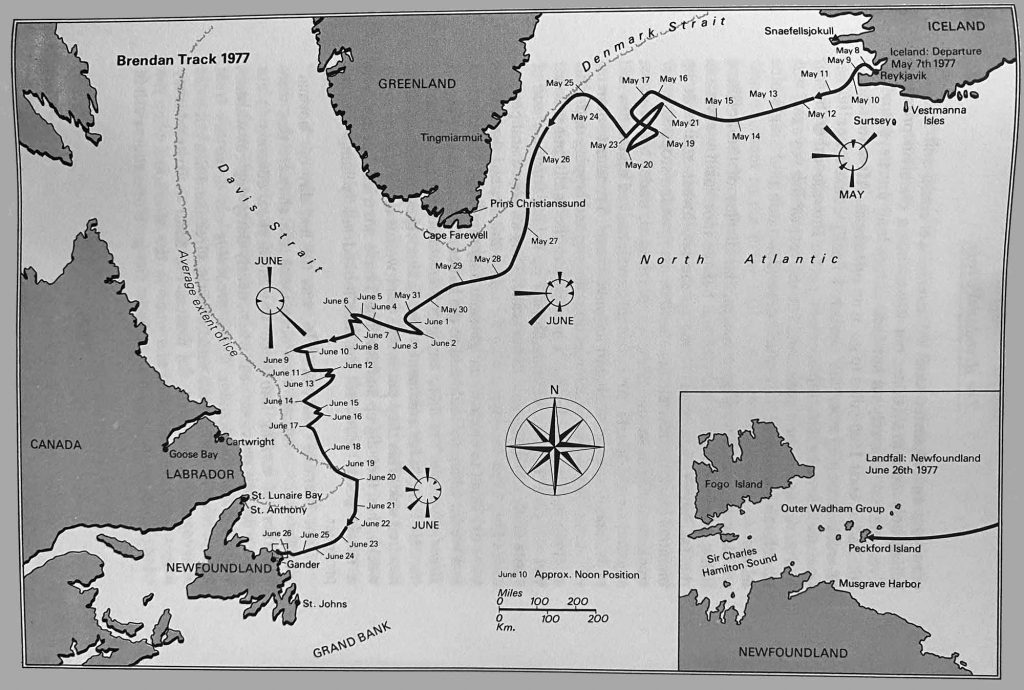
It had always been a good guess that the last leg of the trip would be the hardest, since the waters around Greenland and Labrador are sparsely inhabited and treacherous. That turned out to be true for Brendan , which nearly capsized in stormy weather and suffered damage to her leather hull while navigating through icebergs. It was touch and go at times, but of course, in the end, they were successful. On June 26, 1977 the voyage was completed by landing on Peckford Island, Newfoundland. In the documentary , which includes film from land-based crews as well as onboard footage, we see excited crowds awaiting the boat’s arrival and an impromptu parade celebrating the sailors’ accomplishment.
A successful voyage of course doesn’t prove that Irish monks came to North America a thousand years before Columbus, but it does show that they could have using the technology available to them. I find The Brendan Voyage fascinating for both its historical significance and the way it transpires across so many of my favorite islands. I’m also impressed by how well documented it was, the detail of the book and accompanying film. I’m surprised I hadn’t heard about this adventure before, given that it concluded a full year before I was born. I guess I should consider it Brendan Luck that it finally crossed my path.
I’d suggest getting a physical copy of the The Brendan Voyage book , perhaps seeking out the original 1978 hardcover to ensure it has all of the photographs, maps, and illustrations by Tróndur Patursson.
Whether you read it or not, I highly recommend watching the documentary, which is available on YouTube in two parts and is just under an hour in total.
Finally, you might be interested in this Story Map about The Brendan Voyage , which includes accurate Google Maps showing the route across the North Atlantic.
- Tags boat , faroe islands , greenland , history , iceland , ireland , newfoundland , scotland

St. Brendan the Navigator: The Voyage of the Saint and the Search for the Promised Land
St. Brendan the Navigator, also known as Brendan of Clonfert, is one of the most intriguing figures in the annals of Irish Christianity. Celebrated as a daring seafarer and explorer, he is best known for his legendary voyage in search of the “Promised Land of the Saints.” This article delves into the life of St. Brendan, the tales of his voyages, and the enduring legacy of this adventurous saint.
Early Life and Spiritual Formation
St. Brendan was born around 484 AD in County Kerry, Ireland. He was baptized by St. Erc, a bishop who recognized Brendan’s spiritual potential and provided him with his early education. Brendan was then sent to a monastery school for further education, where he was ordained a priest at the age of 26.
Founding Monasteries
St. Brendan is noted for founding numerous monastic settlements across Ireland. The most famous of these is Clonfert in County Galway, established around 557 AD. These monasteries served as important centers of learning, echoing the Celtic tradition of combining Christian faith with holistic education.
The Voyage of St. Brendan
St. Brendan’s most famous contribution to Irish religious folklore is his legendary voyage across the Atlantic. According to “Navigatio Sancti Brendani Abbatis” (The Voyage of Saint Brendan the Abbot), Brendan was inspired by the story of St. Barinthus, who claimed to have discovered a land of abundance, which Brendan understood to be the “Promised Land of the Saints.”
Intrigued and driven by spiritual curiosity, Brendan decided to undertake a voyage to discover this Promised Land. He reportedly built a curragh, a type of Irish boat with a wooden frame covered in animal hides, and set sail with a group of fellow monks.
Encounters and Miracles
The tales of Brendan’s voyage, which reportedly lasted seven years, are filled with fantastical elements. His journey, as depicted in the Navigatio, included encounters with enormous sea creatures, a floating crystal pillar, an island that turned out to be a sea monster, and a mysterious island inhabited by a hermit.
One of the most captivating stories from Brendan’s voyage is the Easter celebration on the back of a whale. According to the tale, Brendan and his crew, unable to find land during Easter, landed on a small island to hold Mass. As they concluded the service, the island began to move and they realized they had been on the back of a giant sea creature, presumably a whale.
The Land of Promise
The climax of St. Brendan’s voyage was the discovery of the Land of Promise. This land, as described in the Navigatio, was a paradise filled with lush vegetation, abundant flowers, and rich fruits. After spending forty days exploring this land, an angel appeared to Brendan and told him to return to Ireland. The angel informed Brendan that the Land of Promise would remain hidden until the end of time.
Return to Ireland
Following his epic voyage, St. Brendan returned to Ireland where he continued his ecclesiastical work. His accounts of the voyage spread far and wide, inspiring numerous manuscripts and adaptations.
Death and Sainthood
St. Brendan died in 577 AD at the monastery of Annaghdown while visiting his sister Briga. He was buried in Clonfert, and his tomb soon became a pilgrimage site. Although there are no records of his formal canonization, his sainthood was widely recognized by local Christian communities, and he was venerated as the patron saint of sailors and travelers.
Impact and Influence of the Voyage
St. Brendan’s legendary journey ignited the imagination of many explorers in the centuries that followed. The detailed descriptions of his voyage were used as a navigational guide in the Middle Ages, inspiring a belief in a land beyond the known world.
The belief in St. Brendan’s Island, an island supposedly discovered by Brendan during his voyage, persisted on maps until the 19th century. Some have even proposed that Brendan reached the Americas long before Columbus, although this theory is a subject of ongoing debate.
St. Brendan in Art and Literature
The tales of St. Brendan’s voyage have had a lasting influence on art and literature. He has often been depicted in a boat or holding an oar, symbolizing his seafaring adventures. In literature, his voyage has been the subject of numerous adaptations, including novels, poems, and plays.
One of the most famous literary works based on Brendan’s journey is the Latin poem “Navigatio Sancti Brendani,” which dates back to at least the 9th century. This poem has been translated into many languages and has inspired countless retellings.
Modern Celebrations and Veneration
St. Brendan’s feast day is celebrated on May 16th, and he is venerated as the patron saint of sailors, mariners, and travelers. In many coastal communities in Ireland and elsewhere, St. Brendan’s Day is marked with processions and special church services. In addition, many seafaring traditions and customs are associated with St. Brendan, highlighting his enduring influence on maritime culture.
St. Brendan’s Legacy
While the historical accuracy of St. Brendan’s voyage is a subject of debate, its influence on Christian tradition and folklore is undeniable. The stories of his journey continue to captivate the imagination, symbolizing the human quest for spiritual discovery and exploration.
St. Brendan’s life and journey embody the spirit of adventure inherent in the Christian quest for spiritual truth. His voyage represents the journey of the soul towards the divine, navigating through the unknown in search of the Promised Land.
St. Brendan and the Christian Imagination
The tale of St. Brendan’s voyage continues to hold a unique place in the Christian imagination. It combines elements of adventure, faith, and the miraculous, providing a rich narrative that has been retold and reimagined across the centuries.
From a broader perspective, St. Brendan’s voyage can be viewed as a metaphor for the Christian journey through life. Just as Brendan navigated through uncharted waters, facing both peril and wonder, so too does the Christian navigate through the trials and joys of life, guided by faith towards the ultimate Promised Land.
St. Brendan and Irish Cultural Identity
St. Brendan is not only a significant figure in Christian history, but he also holds a special place in Irish cultural identity. His story ties together elements of monastic spirituality, a deep connection with nature, and a spirit of exploration and adventure. As such, St. Brendan embodies many of the qualities and values that are central to Irish cultural identity.
In conclusion, St. Brendan the Navigator remains one of the most fascinating figures in Irish Christian history. His legendary voyage continues to inspire, reminding us of the power of faith, the allure of the unknown, and the limitless possibilities of the human spirit.
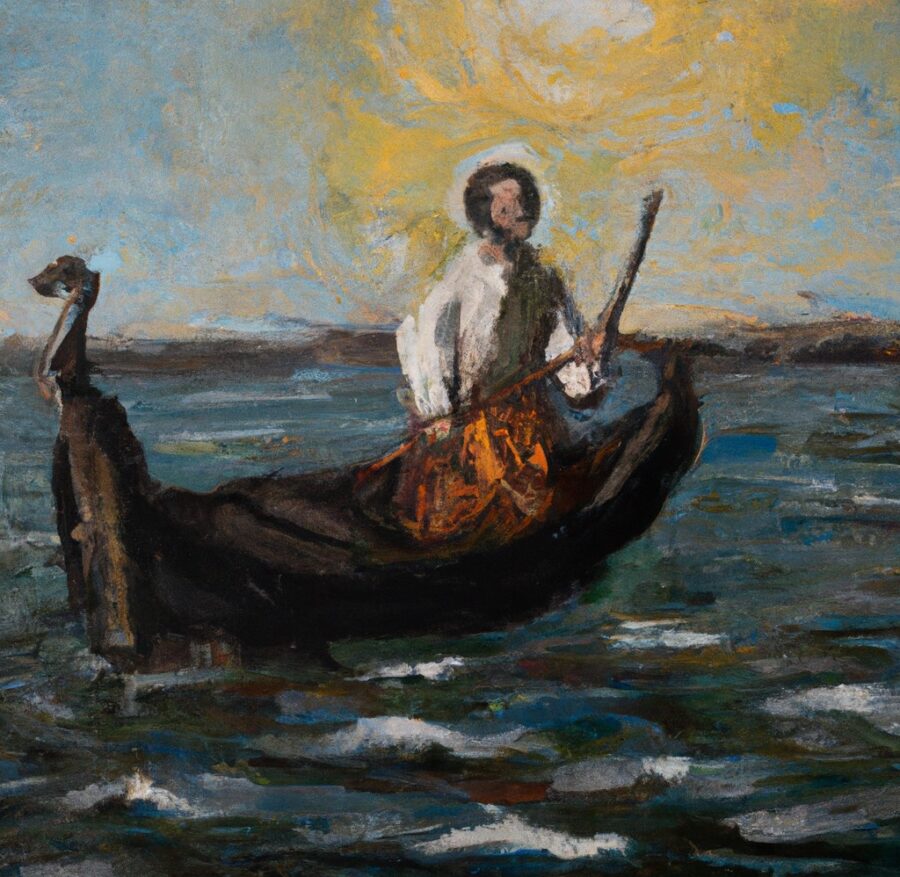
Did you find this helpful?
Related posts.
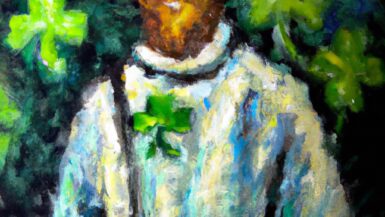
St. Patrick: The Patron Saint of Ireland and His Legendary Exploits
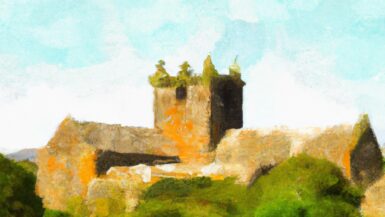
St. Columba: The Irish Saint Who Battled a Monster and Converted Scotland
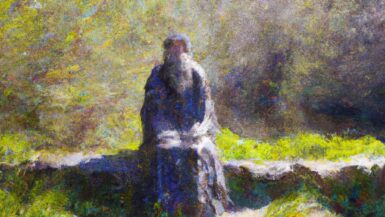
St. Kevin of Glendalough: A Hermit’s Life, Miracles, and the Blackbird’s Nest
Leave a reply cancel reply.
Your email address will not be published. Required fields are marked *
Save my name, email, and website in this browser for the next time I comment.

St. Brendan's Voyage
The deaths of several Irish saints, whose lives are of more than ordinary interest, are recorded about this period. Amongst them, St. Brendan of Clonfert demands more than a passing notice. His early youth was passed under the care of St. Ita, a lady of the princely family of the Desii. By divine command she established the Convent of Cluain Credhuil , in the present county of Limerick, and there, it would appear, she devoted herself specially to the care of youth. When Brendan had attained his fifth year, he was placed under the protection of Bishop Ercus, from whom he received such instruction as befitted his advancing years. But Brendan's tenderest affection clung to the gentle nurse of his infancy; and to her, in after years, he frequently returned, to give or receive counsel and sympathy.
The legend of his western voyage, if not the most important, is at least the most interesting part of his history. Kerry was the native home of the enterprising saint; and as he stood on its bold and beautiful shores, his naturally contemplative mind was led to inquire what boundaries chained that vast ocean, whose grand waters rolled in mighty waves beneath his feet. His thoughtful piety suggested that where there might be a country there might be life—human life and human souls dying day by day, and hour by hour, and knowing of no other existence than that which at best is full of sadness and decay.
Traditions of a far-away land had long existed on the western coast of ancient Erinn. The brave Tuatha Dé Dananns were singularly expert in naval affairs, and their descendants were by no means unwilling to impart information to the saint.
The venerable St. Enda, the first Abbot of Arran, was then living, and thither St. Brendan journeyed for counsel. Probably he was encouraged in his design by the holy abbot; for he proceeded along the coast of Mayo, inquiring as he went for traditions of the western continent. On his return to Kerry, he decided to set out on the important expedition. St. Brendan's Hill still bears his name; and from the bay at the foot of this lofty eminence he sailed for the "far west." Directing his course towards the south-west, with a few faithful companions, in a well-provisioned bark, he came, after some rough and dangerous navigation, to calm seas, where, without aid of oar or sail, he was borne along for many weeks. It is probable that he had entered the great Gulf Stream, which brought his vessel ashore somewhere on the Virginian coasts. He landed with his companions, and penetrated into the interior, until he came to a large river flowing from east to west , supposed to be that now known as the Ohio. Here, according to the legend, he was accosted by a man of venerable bearing, who told him that he had gone far enough; that further discoveries were reserved for other men, who would in due time come and christianize that pleasant land.
After an absence of seven years, the saint returned once more to Ireland, and lived not only to tell of the marvels he had seen, but even to found a college of three thousand monks at Clonfert. This voyage took place in the year 545, according to Colgan; but as St. Brendan must have been at that time at least sixty years old, an earlier date has been suggested as more probable. [8]
The northern and southern Hy-Nials had long held rule in Ireland; but while the northern tribe were ever distinguished, not only for their valour, but for their chivalry in field or court, the southern race fell daily lower in the estimation of their countrymen. Their disgrace was completed when two kings, who ruled Erinn jointly, were treacherously slain by Conall Guthvin. For this crime the family were excluded from regal honours for several generations.
Home dissensions led to fatal appeals for foreign aid, and this frequently from the oppressing party. Thus, Congal Caech, who killed the reigning sovereign in 623, fled to Britain, and after remaining there nine years, returned with foreign troops, by whose assistance he hoped to attain the honours unlawfully coveted. The famous battle of Magh-Rath, [9] in which the auxiliaries were utterly routed, and the false Congal slain, unfortunately did not deter his countrymen from again and again attempting the same suicidal course.
[8] Probable .—The legend of St. Brendan was widely diffused in the Middle Ages. In the Bibliothéque Impériale , at Paris, there are no less than eleven MSS. of the original Latin legend, the dates of which vary from the eleventh to the fourteenth century. In the old French and Romance dialects there are abundant copies in most public libraries in France; while versions in Irish, Dutch, German, Italian; Spanish, and Portuguese, abound in all parts of the Continent. Traces of ante-Columbian voyages to America are continually cropping up. But the appearance, in 1837, of the Antiquitates Americanos sive ita Scriptores Septentrionales rerum ante-Columbiarum , in America, edited by Professor Rafu, at Copenhagen, has given final and conclusive evidence on this interesting subject. America owes its name to an accidental landing. Nor is it at all improbable that the Phoenicians, in their voyage across the stormy Bay of Biscay, or the wild Gulf of Guinea, may have been driven far out of their course to western lands. Even in 1833 a Japanese junk was wrecked upon the coast of Oregon. Humboldt believes that the Canary Isles were known, not only to the Phoenicians, but "perhaps even to the Etruscans." There is a map in the Library of St. Mark, at Venice, made in the year 1436, where an island is delineated and named Antillia. See Trans. R.I.A. vol. xiv. A distinguished modern poet of Ireland has made the voyage of St. Brendan the subject of one of the most beautiful of his poems.
[9] Magh-Rath. —Now Moira, in the county Down. The Chronicum Scotorum gives the date 636, and the Annals of Tighernach at 637, which Dr. O'Donovan considers to be the true date.

Saint Brendan and His Epic Voyage: Was the Irish Saint the First European in the New World?
- Read Later
Saint Brendan (also referred to by his various epithets ‘the Navigator’, ‘the Voyager’, ‘the Anchorite’, and ‘the Bold’) was an Irish saint who lived between the 5th and 6th centuries AD known for his legendary voyage in search of the ‘Island of Paradise’ or the ‘Land of Promise of the Saints’.
Part of the early Irish monastic tradition, St. Brendan traveled around northwest Europe to preach the Christian faith and to found monasteries. Whilst there is no historical proof available at present to support his famous voyage, the fantastic adventures of the saint were compiled into a piece of literary work known as the ‘ Navigatio Sancti Brendani Abbatis ’ (Voyage of St. Brendan the Abbot).
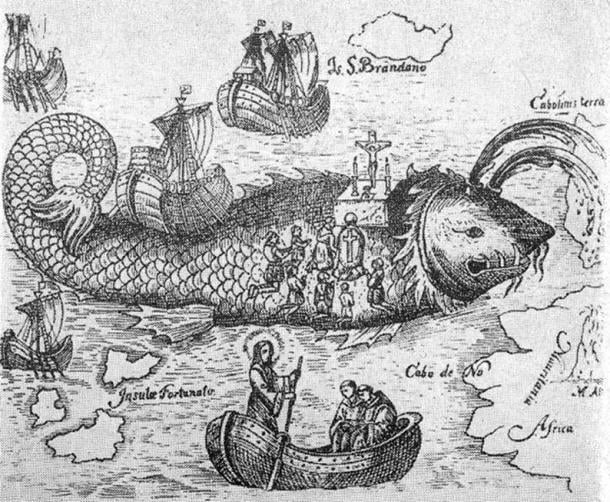
A woodcut which shows the scene from Navigatio Sancti Brendani Abbatis where the saint celebrates a mass on the body of a sea monster. ( Public Domain )
St. Brendan’s Ordination
St. Brendan is recorded to have been born in 484 AD, in Ciarraighe Luachra, near Tralee, a port town in the southwestern Irish county of County Kerry, which is part of the province of Munster. The records also indicate that the future saint was baptized by Saint Erc, another Irish saint, at Tubrid, near Ardfert. After a year with his parents, the child Brendan was sent to the home of a local chieftain, Airde mac Fidaigh at Cathair Airde in Listrim, about 5 km (3.11 miles) to the east of his home. At the end of his fifth year, St. Brendan returned to his family, and continued his studies under Saint Erc. In 510 AD, the saint was ordained a priest by his teacher (another source provides 512 AD as the year in which the saint was ordained).
- True Remains of the Saint Behind the Santa Myth Believed Found in Turkey
- The Immortal Count of Saint Germaine: Ascended Master of Ancient Wisdom
- Viva La Muerte! Santa Muerte, Folk Saint and Holy Personification of Death, Healer and Protector
In the following years, Saint Brendan traveled around the British Isles, spreading Christianity, and founding monastic communities. Some of the monasteries he founded included the ones at Clonfert, in County Galway (which is his largest and most celebrated), at Inis-da-druim (present day Coney Island), in County Clare, and at Shanakeel (known also as Baalynevinoorach), located at the foot of Brandon Hill in County Kerry. Additionally, St. Brendan is also remembered as a voyager thanks to the account of his fantastic voyage in search of the Island of Paradise.
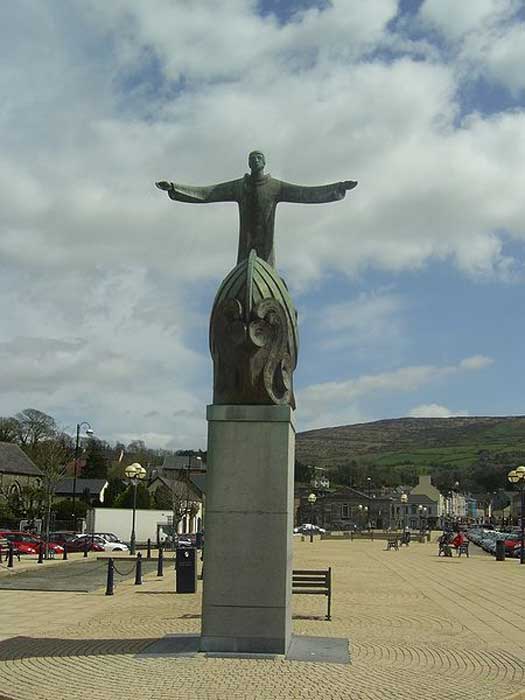
Sculpture of St Brendan, The Square Bantry, County Cork. ( Public Domain )
St. Brendan’s Encounter with a Sea Monster
An account of St. Brendan’s journey to the Island of Paradise may be found in a text known as the ‘ Navigatio Sancti Brendani Abbatis ’, which was written down around the 9th century AD. Several variations are available, which has resulted in some differences in the details of the story. For example, St. Brendan is recorded to have not undertaken the voyage alone, but accompanied by a group of his fellow monks. The number of his companions, however, varies according to the sources, ranging from as few as 14 to as many as 60. In any case, the monks’ voyage took seven years to complete, during which they encountered a number of incredible adventures.
One of these, for example, is the monks’ encounter with the sea monster Jasconius. This tale is said to be the most commonly illustrated adventure of St. Brendan. In the tale, the monks mistake the monster as an island, due to its immense size, and went onto its back. They only realized that their island was in fact a living creature when they made their campfire, as it woke the sea monster up. In one version of the tale, the monks encountered a sea monster that sought to devour them instead. The saint prayed to God for deliverance, and another sea monster emerged from the water to slay the first monster.
- Saint Augustine of Hippo and His Detours on the Long and Winding Path to Christianity
- The Historical Count of Saint-Germaine: Elusive, Enigmatic and Eternal
- When Millions Were Dropping Dead From the Plague, The 14 Holy Helpers Were Summoned to Intercede
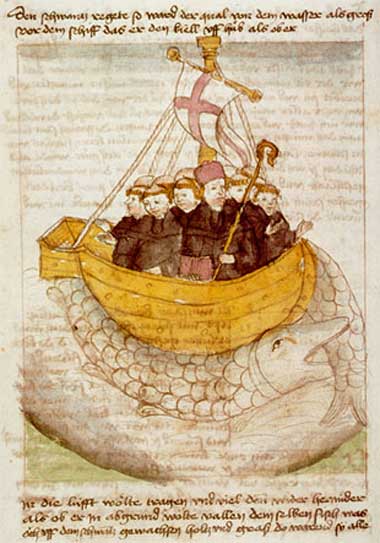
Saint Brendan and the whale from a 15th-century manuscript. ( Public Domain )
Did Saint Brendan Reach the New World?
The voyage of Saint Brendan has led some to argue that it was this Irish saint, rather than the Vikings or Christopher Columbus, who was the first European to have reached the New World. One of the people who sought to determine the veracity of this claim was Tim Severin, a British explorer.
In 1976, Severin built a traditional ship using the design, materials, and techniques that the monks would have used. The explorer successfully sailed from Ireland to North America. Whilst this does not necessarily mean that St. Brendan was the first European to reach the New World, it does demonstrate that the voyage undertaken by the saint was entirely possible.
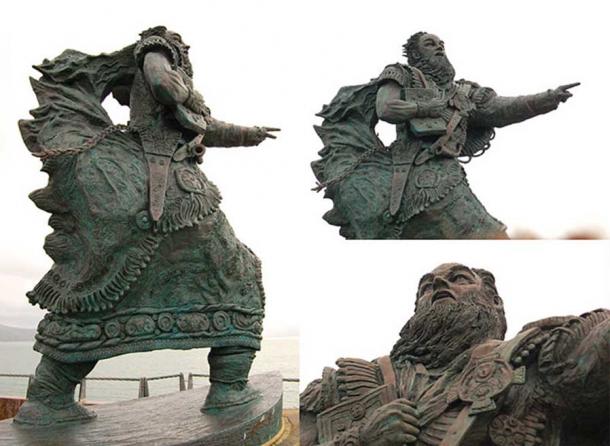
Statue of Brendan at Fenit Harbour. ( CC BY SA 3.0 )
Top image: Exhibit in the Chazen Museum of Art, University of Wisconsin-Madison, Madison, Wisconsin, USA. Source: Public Domain
By Wu Mingren
Anon., The Voyage of St Brendan the Abbot [Online]
[O’Donoghue, D. (trans.) 1893. The Voyage of St Brendan the Abbot .] Available at: http://markjberry.blogs.com/StBrendan.pdf
Grattan-Flood, W. & Hartig, O., 1907. St. Brendan. [Online] Available at: http://www.newadvent.org/cathen/02758c.htm
Haggerty, B., 2011. St. Brendan,The Navigator. [Online] Available at: http://www.irishcultureandcustoms.com/ASaints/BrendanNav.html
Howley, A., 2013. Did St. Brendan Reach North America 500 Years Before the Vikings?. [Online] Available at: https://voices.nationalgeographic.org/2013/05/16/did-st-brendan-reach-north-america-500-years-before-the-vikings/
Newfoundland and Labrador Heritage, 2017. Irish Monks and the Voyage of St. Brendan. [Online] Available at: http://www.heritage.nf.ca/articles/exploration/st-brendan-voyage.php
www.saint-brendan.org , 2010. Saint Brendan The Navigator. [Online] Available at: http://www.saint-brendan.org/index.asp
seems there comes a time when many people so called discovered america even thousands of years ago

Wu Mingren (‘Dhwty’) has a Bachelor of Arts in Ancient History and Archaeology. Although his primary interest is in the ancient civilizations of the Near East, he is also interested in other geographical regions, as well as other time periods.... Read More
Related Articles on Ancient-Origins
- Skip to content

- Explore our archive
Tim Severin's The Brendan Voyage
While cataloguing the Irish Folklife currach collection, I am always conscious that the boats I am working on are as far from their natural environment as they could possibly be. While most of them once worked the inshore fishing spots of the Irish west coast and rested out in the open when not in use, they are now safely stored indoors in environmentally controlled conditions that will ensure their preservation. As a result of their being stored indoors, both prior to and after the National Museum of Ireland acquired them, the skins of some of our boats have dried out and become hard and inflexible. Except for those who have taken to the water in a currach over a lengthy period, it is difficult to appreciate how their simple design and natural materials will perform when faced with the harsh truths of the sea and the elements. Part of my work on our planned boat gallery at the National Museum of Ireland – Country Life is to talk to fishermen who worked, and still work, with currachs to understand the boat’s capabilities. Unfortunately, pandemic restrictions have prevented me from carrying out fieldwork and interviews but there are sources that provide first-hand accounts of experiencing travel by currach. Tim Severin’s book The Brendan Voyage is one of those sources.

Tim Severin (1940-2020). Photograph from www.timseverin.net.
Tim Severin was an explorer, author and historian who sadly passed away last month at the age of 80. Throughout 1976-1977, Severin led a small group of fellow explorers as they sailed the journey from Ireland west across the Atlantic Ocean to the Promised Land believed to have been completed by Saint Brendan in the sixth century. Saint Brendan had made the journey in a large currach made of a wooden frame and covered with tanned oxhides. Severin’s aim was to see whether Saint Brendan’s journey had been possible and to do that the group’s vessel would have to be as close a replica of the saint’s boat as possible which also meant using materials and building methods from that time.

The Brendan currach under construction in Crosshaven Boatyard showing its primitive wooden skeleton and hide skin. Photograph by Ian Yeomans.
The finished 36 foot boat, named Brendan, had a double gunwale of oak. Leather thongs were used to lash the ash frame together and the outside of the hull was then covered with 49 quarter of an inch thick oxhides that were stitched together and finished with a wool grease coating. Brendan’s two masts and oars were also made from ash and flax made suitable sails and ropes.

The Brendan currach. Photograph by Cotton Coulson.
The impressive construction of the boat was informed by thorough research, but how would she handle on the open waters of the rough Atlantic? Here, The Brendan Voyage gives us many practical and poetic descriptions of Brendan’s capabilities. Severin describes how Brendan’s light frame meant the boat could mould to the many waves that pounded its shell. The flexibility offered by the leather skin developed in Severin ‘a sense of being part of the sea’s motion’. He believed the leather survived so well in part due to the cold waters of the Atlantic.
The sides of the boat pumped gently in and out as though the Brendan were breathing
When Brendan was holed by drifting ice in the dangerous stretch between Greenland and Newfoundland, crew member George Molony had the unpleasant job of hanging over the gunwale in water temperatures as low as zero degrees centigrade in order to patch and stitch the hull while the boat kept sailing. Up to that point, ice had been glancing rather harmlessly off the curved hull of the currach.

Patches on the canvas skin of a National Museum of Ireland currach from Inis Oírr. © National Museum of Ireland.
The combination of Brendan’s medieval design and natural materials made it an extremely durable boat. Even during sea trials in advance of launching from Ireland, deliberate attempts to capsize Brendan were extraordinarily difficult. The currach could also be fast, when conditions were right. Brendan’s best 24-hour distance was an impressive 115 miles. Brendan reached her destination in June 1977. The large currach’s epic journey had proven that, in Tim Severin’s own words, ‘she was a true ocean-going vessel, and there was no longer any practical objection to the idea that Irish monks might have sailed their leather boats to North America before the Norsemen, and long before Columbus.’
My thanks to Afloat.ie for assistance in sourcing images.
Severin, Tim, The Brendan Voyage , London: Arrow Books Ltd., 1979.
Comments about this page
Hello Bill. The Brendan boat is on public display at Craggaunowen Castle in Co. Clare.
I just finished reading the Modern Library Exploration Edition of The Brendan Voyage and was amazed at the determination of the Crew through the entire process. I did wonder if the Brendan went to a museum after her adventure? It would have been a task to keep her in seaworthy condition, but as an old Sailor I hope she is still around. Great book overall.
Had the honor to meet Tim Severin onboard NatGeo’s Explorer May 2019 when he was a guest lecturer. He was engaging and his explorations so interesting. His contribution appreciated.
He will be missed by all.
Reading this brought back childhood memories of when the Brendan had to make an unscheduled stop at Ballywhoriskey along the Fanad coastline. I just submitted my words on it.
Thanks for your brief synopsis, it is a fascinating story. Mr Severin was a very brave man obviously a driven man but he must have done his research to a great extent to gather confidence for the journey. I love the sea but the thoughts of that challenge that they did with great success was truely remarkable. So proud of my name and of Mr. Severin. What a man!

Add a comment about this page
Your email address will not be published. Required fields are marked *
Your comment:
I consent to my name and e-mail address being stored along with this comment, and to the website editors communicating with me by e-mail about the comment if necessary. My name may be published alongside the comment on the website, but my e-mail address will not be published. My information will not be shared with any third party (see our Privacy Statement - opens in a new window ). *

- Terms of use
- Accessibility
- Admin login
- Search Menu
- Browse content in Arts and Humanities
- Browse content in Archaeology
- Anglo-Saxon and Medieval Archaeology
- Archaeological Methodology and Techniques
- Archaeology by Region
- Archaeology of Religion
- Archaeology of Trade and Exchange
- Biblical Archaeology
- Contemporary and Public Archaeology
- Environmental Archaeology
- Historical Archaeology
- History and Theory of Archaeology
- Industrial Archaeology
- Landscape Archaeology
- Mortuary Archaeology
- Prehistoric Archaeology
- Underwater Archaeology
- Urban Archaeology
- Zooarchaeology
- Browse content in Architecture
- Architectural Structure and Design
- History of Architecture
- Residential and Domestic Buildings
- Theory of Architecture
- Browse content in Art
- Art Subjects and Themes
- History of Art
- Industrial and Commercial Art
- Theory of Art
- Biographical Studies
- Byzantine Studies
- Browse content in Classical Studies
- Classical History
- Classical Philosophy
- Classical Mythology
- Classical Literature
- Classical Reception
- Classical Art and Architecture
- Classical Oratory and Rhetoric
- Greek and Roman Papyrology
- Greek and Roman Epigraphy
- Greek and Roman Law
- Greek and Roman Archaeology
- Late Antiquity
- Religion in the Ancient World
- Digital Humanities
- Browse content in History
- Colonialism and Imperialism
- Diplomatic History
- Environmental History
- Genealogy, Heraldry, Names, and Honours
- Genocide and Ethnic Cleansing
- Historical Geography
- History by Period
- History of Emotions
- History of Agriculture
- History of Education
- History of Gender and Sexuality
- Industrial History
- Intellectual History
- International History
- Labour History
- Legal and Constitutional History
- Local and Family History
- Maritime History
- Military History
- National Liberation and Post-Colonialism
- Oral History
- Political History
- Public History
- Regional and National History
- Revolutions and Rebellions
- Slavery and Abolition of Slavery
- Social and Cultural History
- Theory, Methods, and Historiography
- Urban History
- World History
- Browse content in Language Teaching and Learning
- Language Learning (Specific Skills)
- Language Teaching Theory and Methods
- Browse content in Linguistics
- Applied Linguistics
- Cognitive Linguistics
- Computational Linguistics
- Forensic Linguistics
- Grammar, Syntax and Morphology
- Historical and Diachronic Linguistics
- History of English
- Language Evolution
- Language Reference
- Language Acquisition
- Language Variation
- Language Families
- Lexicography
- Linguistic Anthropology
- Linguistic Theories
- Linguistic Typology
- Phonetics and Phonology
- Psycholinguistics
- Sociolinguistics
- Translation and Interpretation
- Writing Systems
- Browse content in Literature
- Bibliography
- Children's Literature Studies
- Literary Studies (Romanticism)
- Literary Studies (American)
- Literary Studies (Asian)
- Literary Studies (European)
- Literary Studies (Eco-criticism)
- Literary Studies (Modernism)
- Literary Studies - World
- Literary Studies (1500 to 1800)
- Literary Studies (19th Century)
- Literary Studies (20th Century onwards)
- Literary Studies (African American Literature)
- Literary Studies (British and Irish)
- Literary Studies (Early and Medieval)
- Literary Studies (Fiction, Novelists, and Prose Writers)
- Literary Studies (Gender Studies)
- Literary Studies (Graphic Novels)
- Literary Studies (History of the Book)
- Literary Studies (Plays and Playwrights)
- Literary Studies (Poetry and Poets)
- Literary Studies (Postcolonial Literature)
- Literary Studies (Queer Studies)
- Literary Studies (Science Fiction)
- Literary Studies (Travel Literature)
- Literary Studies (War Literature)
- Literary Studies (Women's Writing)
- Literary Theory and Cultural Studies
- Mythology and Folklore
- Shakespeare Studies and Criticism
- Browse content in Media Studies
- Browse content in Music
- Applied Music
- Dance and Music
- Ethics in Music
- Ethnomusicology
- Gender and Sexuality in Music
- Medicine and Music
- Music Cultures
- Music and Media
- Music and Religion
- Music and Culture
- Music Education and Pedagogy
- Music Theory and Analysis
- Musical Scores, Lyrics, and Libretti
- Musical Structures, Styles, and Techniques
- Musicology and Music History
- Performance Practice and Studies
- Race and Ethnicity in Music
- Sound Studies
- Browse content in Performing Arts
- Browse content in Philosophy
- Aesthetics and Philosophy of Art
- Epistemology
- Feminist Philosophy
- History of Western Philosophy
- Metaphysics
- Moral Philosophy
- Non-Western Philosophy
- Philosophy of Language
- Philosophy of Mind
- Philosophy of Perception
- Philosophy of Science
- Philosophy of Action
- Philosophy of Law
- Philosophy of Religion
- Philosophy of Mathematics and Logic
- Practical Ethics
- Social and Political Philosophy
- Browse content in Religion
- Biblical Studies
- Christianity
- East Asian Religions
- History of Religion
- Judaism and Jewish Studies
- Qumran Studies
- Religion and Education
- Religion and Health
- Religion and Politics
- Religion and Science
- Religion and Law
- Religion and Art, Literature, and Music
- Religious Studies
- Browse content in Society and Culture
- Cookery, Food, and Drink
- Cultural Studies
- Customs and Traditions
- Ethical Issues and Debates
- Hobbies, Games, Arts and Crafts
- Lifestyle, Home, and Garden
- Natural world, Country Life, and Pets
- Popular Beliefs and Controversial Knowledge
- Sports and Outdoor Recreation
- Technology and Society
- Travel and Holiday
- Visual Culture
- Browse content in Law
- Arbitration
- Browse content in Company and Commercial Law
- Commercial Law
- Company Law
- Browse content in Comparative Law
- Systems of Law
- Competition Law
- Browse content in Constitutional and Administrative Law
- Government Powers
- Judicial Review
- Local Government Law
- Military and Defence Law
- Parliamentary and Legislative Practice
- Construction Law
- Contract Law
- Browse content in Criminal Law
- Criminal Procedure
- Criminal Evidence Law
- Sentencing and Punishment
- Employment and Labour Law
- Environment and Energy Law
- Browse content in Financial Law
- Banking Law
- Insolvency Law
- History of Law
- Human Rights and Immigration
- Intellectual Property Law
- Browse content in International Law
- Private International Law and Conflict of Laws
- Public International Law
- IT and Communications Law
- Jurisprudence and Philosophy of Law
- Law and Politics
- Law and Society
- Browse content in Legal System and Practice
- Courts and Procedure
- Legal Skills and Practice
- Primary Sources of Law
- Regulation of Legal Profession
- Medical and Healthcare Law
- Browse content in Policing
- Criminal Investigation and Detection
- Police and Security Services
- Police Procedure and Law
- Police Regional Planning
- Browse content in Property Law
- Personal Property Law
- Study and Revision
- Terrorism and National Security Law
- Browse content in Trusts Law
- Wills and Probate or Succession
- Browse content in Medicine and Health
- Browse content in Allied Health Professions
- Arts Therapies
- Clinical Science
- Dietetics and Nutrition
- Occupational Therapy
- Operating Department Practice
- Physiotherapy
- Radiography
- Speech and Language Therapy
- Browse content in Anaesthetics
- General Anaesthesia
- Neuroanaesthesia
- Clinical Neuroscience
- Browse content in Clinical Medicine
- Acute Medicine
- Cardiovascular Medicine
- Clinical Genetics
- Clinical Pharmacology and Therapeutics
- Dermatology
- Endocrinology and Diabetes
- Gastroenterology
- Genito-urinary Medicine
- Geriatric Medicine
- Infectious Diseases
- Medical Toxicology
- Medical Oncology
- Pain Medicine
- Palliative Medicine
- Rehabilitation Medicine
- Respiratory Medicine and Pulmonology
- Rheumatology
- Sleep Medicine
- Sports and Exercise Medicine
- Community Medical Services
- Critical Care
- Emergency Medicine
- Forensic Medicine
- Haematology
- History of Medicine
- Browse content in Medical Skills
- Clinical Skills
- Communication Skills
- Nursing Skills
- Surgical Skills
- Browse content in Medical Dentistry
- Oral and Maxillofacial Surgery
- Paediatric Dentistry
- Restorative Dentistry and Orthodontics
- Surgical Dentistry
- Medical Ethics
- Medical Statistics and Methodology
- Browse content in Neurology
- Clinical Neurophysiology
- Neuropathology
- Nursing Studies
- Browse content in Obstetrics and Gynaecology
- Gynaecology
- Occupational Medicine
- Ophthalmology
- Otolaryngology (ENT)
- Browse content in Paediatrics
- Neonatology
- Browse content in Pathology
- Chemical Pathology
- Clinical Cytogenetics and Molecular Genetics
- Histopathology
- Medical Microbiology and Virology
- Patient Education and Information
- Browse content in Pharmacology
- Psychopharmacology
- Browse content in Popular Health
- Caring for Others
- Complementary and Alternative Medicine
- Self-help and Personal Development
- Browse content in Preclinical Medicine
- Cell Biology
- Molecular Biology and Genetics
- Reproduction, Growth and Development
- Primary Care
- Professional Development in Medicine
- Browse content in Psychiatry
- Addiction Medicine
- Child and Adolescent Psychiatry
- Forensic Psychiatry
- Learning Disabilities
- Old Age Psychiatry
- Psychotherapy
- Browse content in Public Health and Epidemiology
- Epidemiology
- Public Health
- Browse content in Radiology
- Clinical Radiology
- Interventional Radiology
- Nuclear Medicine
- Radiation Oncology
- Reproductive Medicine
- Browse content in Surgery
- Cardiothoracic Surgery
- Gastro-intestinal and Colorectal Surgery
- General Surgery
- Neurosurgery
- Paediatric Surgery
- Peri-operative Care
- Plastic and Reconstructive Surgery
- Surgical Oncology
- Transplant Surgery
- Trauma and Orthopaedic Surgery
- Vascular Surgery
- Browse content in Science and Mathematics
- Browse content in Biological Sciences
- Aquatic Biology
- Biochemistry
- Bioinformatics and Computational Biology
- Developmental Biology
- Ecology and Conservation
- Evolutionary Biology
- Genetics and Genomics
- Microbiology
- Molecular and Cell Biology
- Natural History
- Plant Sciences and Forestry
- Research Methods in Life Sciences
- Structural Biology
- Systems Biology
- Zoology and Animal Sciences
- Browse content in Chemistry
- Analytical Chemistry
- Computational Chemistry
- Crystallography
- Environmental Chemistry
- Industrial Chemistry
- Inorganic Chemistry
- Materials Chemistry
- Medicinal Chemistry
- Mineralogy and Gems
- Organic Chemistry
- Physical Chemistry
- Polymer Chemistry
- Study and Communication Skills in Chemistry
- Theoretical Chemistry
- Browse content in Computer Science
- Artificial Intelligence
- Computer Architecture and Logic Design
- Game Studies
- Human-Computer Interaction
- Mathematical Theory of Computation
- Programming Languages
- Software Engineering
- Systems Analysis and Design
- Virtual Reality
- Browse content in Computing
- Business Applications
- Computer Security
- Computer Games
- Computer Networking and Communications
- Digital Lifestyle
- Graphical and Digital Media Applications
- Operating Systems
- Browse content in Earth Sciences and Geography
- Atmospheric Sciences
- Environmental Geography
- Geology and the Lithosphere
- Maps and Map-making
- Meteorology and Climatology
- Oceanography and Hydrology
- Palaeontology
- Physical Geography and Topography
- Regional Geography
- Soil Science
- Urban Geography
- Browse content in Engineering and Technology
- Agriculture and Farming
- Biological Engineering
- Civil Engineering, Surveying, and Building
- Electronics and Communications Engineering
- Energy Technology
- Engineering (General)
- Environmental Science, Engineering, and Technology
- History of Engineering and Technology
- Mechanical Engineering and Materials
- Technology of Industrial Chemistry
- Transport Technology and Trades
- Browse content in Environmental Science
- Applied Ecology (Environmental Science)
- Conservation of the Environment (Environmental Science)
- Environmental Sustainability
- Environmentalist Thought and Ideology (Environmental Science)
- Management of Land and Natural Resources (Environmental Science)
- Natural Disasters (Environmental Science)
- Nuclear Issues (Environmental Science)
- Pollution and Threats to the Environment (Environmental Science)
- Social Impact of Environmental Issues (Environmental Science)
- History of Science and Technology
- Browse content in Materials Science
- Ceramics and Glasses
- Composite Materials
- Metals, Alloying, and Corrosion
- Nanotechnology
- Browse content in Mathematics
- Applied Mathematics
- Biomathematics and Statistics
- History of Mathematics
- Mathematical Education
- Mathematical Finance
- Mathematical Analysis
- Numerical and Computational Mathematics
- Probability and Statistics
- Pure Mathematics
- Browse content in Neuroscience
- Cognition and Behavioural Neuroscience
- Development of the Nervous System
- Disorders of the Nervous System
- History of Neuroscience
- Invertebrate Neurobiology
- Molecular and Cellular Systems
- Neuroendocrinology and Autonomic Nervous System
- Neuroscientific Techniques
- Sensory and Motor Systems
- Browse content in Physics
- Astronomy and Astrophysics
- Atomic, Molecular, and Optical Physics
- Biological and Medical Physics
- Classical Mechanics
- Computational Physics
- Condensed Matter Physics
- Electromagnetism, Optics, and Acoustics
- History of Physics
- Mathematical and Statistical Physics
- Measurement Science
- Nuclear Physics
- Particles and Fields
- Plasma Physics
- Quantum Physics
- Relativity and Gravitation
- Semiconductor and Mesoscopic Physics
- Browse content in Psychology
- Affective Sciences
- Clinical Psychology
- Cognitive Psychology
- Cognitive Neuroscience
- Criminal and Forensic Psychology
- Developmental Psychology
- Educational Psychology
- Evolutionary Psychology
- Health Psychology
- History and Systems in Psychology
- Music Psychology
- Neuropsychology
- Organizational Psychology
- Psychological Assessment and Testing
- Psychology of Human-Technology Interaction
- Psychology Professional Development and Training
- Research Methods in Psychology
- Social Psychology
- Browse content in Social Sciences
- Browse content in Anthropology
- Anthropology of Religion
- Human Evolution
- Medical Anthropology
- Physical Anthropology
- Regional Anthropology
- Social and Cultural Anthropology
- Theory and Practice of Anthropology
- Browse content in Business and Management
- Business Ethics
- Business Strategy
- Business History
- Business and Technology
- Business and Government
- Business and the Environment
- Comparative Management
- Corporate Governance
- Corporate Social Responsibility
- Entrepreneurship
- Health Management
- Human Resource Management
- Industrial and Employment Relations
- Industry Studies
- Information and Communication Technologies
- International Business
- Knowledge Management
- Management and Management Techniques
- Operations Management
- Organizational Theory and Behaviour
- Pensions and Pension Management
- Public and Nonprofit Management
- Strategic Management
- Supply Chain Management
- Browse content in Criminology and Criminal Justice
- Criminal Justice
- Criminology
- Forms of Crime
- International and Comparative Criminology
- Youth Violence and Juvenile Justice
- Development Studies
- Browse content in Economics
- Agricultural, Environmental, and Natural Resource Economics
- Asian Economics
- Behavioural Finance
- Behavioural Economics and Neuroeconomics
- Econometrics and Mathematical Economics
- Economic History
- Economic Systems
- Economic Methodology
- Economic Development and Growth
- Financial Markets
- Financial Institutions and Services
- General Economics and Teaching
- Health, Education, and Welfare
- History of Economic Thought
- International Economics
- Labour and Demographic Economics
- Law and Economics
- Macroeconomics and Monetary Economics
- Microeconomics
- Public Economics
- Urban, Rural, and Regional Economics
- Welfare Economics
- Browse content in Education
- Adult Education and Continuous Learning
- Care and Counselling of Students
- Early Childhood and Elementary Education
- Educational Equipment and Technology
- Educational Strategies and Policy
- Higher and Further Education
- Organization and Management of Education
- Philosophy and Theory of Education
- Schools Studies
- Secondary Education
- Teaching of a Specific Subject
- Teaching of Specific Groups and Special Educational Needs
- Teaching Skills and Techniques
- Browse content in Environment
- Applied Ecology (Social Science)
- Climate Change
- Conservation of the Environment (Social Science)
- Environmentalist Thought and Ideology (Social Science)
- Natural Disasters (Environment)
- Social Impact of Environmental Issues (Social Science)
- Browse content in Human Geography
- Cultural Geography
- Economic Geography
- Political Geography
- Browse content in Interdisciplinary Studies
- Communication Studies
- Museums, Libraries, and Information Sciences
- Browse content in Politics
- African Politics
- Asian Politics
- Chinese Politics
- Comparative Politics
- Conflict Politics
- Elections and Electoral Studies
- Environmental Politics
- European Union
- Foreign Policy
- Gender and Politics
- Human Rights and Politics
- Indian Politics
- International Relations
- International Organization (Politics)
- International Political Economy
- Irish Politics
- Latin American Politics
- Middle Eastern Politics
- Political Behaviour
- Political Economy
- Political Institutions
- Political Methodology
- Political Communication
- Political Philosophy
- Political Sociology
- Political Theory
- Politics and Law
- Public Policy
- Public Administration
- Quantitative Political Methodology
- Regional Political Studies
- Russian Politics
- Security Studies
- State and Local Government
- UK Politics
- US Politics
- Browse content in Regional and Area Studies
- African Studies
- Asian Studies
- East Asian Studies
- Japanese Studies
- Latin American Studies
- Middle Eastern Studies
- Native American Studies
- Scottish Studies
- Browse content in Research and Information
- Research Methods
- Browse content in Social Work
- Addictions and Substance Misuse
- Adoption and Fostering
- Care of the Elderly
- Child and Adolescent Social Work
- Couple and Family Social Work
- Developmental and Physical Disabilities Social Work
- Direct Practice and Clinical Social Work
- Emergency Services
- Human Behaviour and the Social Environment
- International and Global Issues in Social Work
- Mental and Behavioural Health
- Social Justice and Human Rights
- Social Policy and Advocacy
- Social Work and Crime and Justice
- Social Work Macro Practice
- Social Work Practice Settings
- Social Work Research and Evidence-based Practice
- Welfare and Benefit Systems
- Browse content in Sociology
- Childhood Studies
- Community Development
- Comparative and Historical Sociology
- Economic Sociology
- Gender and Sexuality
- Gerontology and Ageing
- Health, Illness, and Medicine
- Marriage and the Family
- Migration Studies
- Occupations, Professions, and Work
- Organizations
- Population and Demography
- Race and Ethnicity
- Social Theory
- Social Movements and Social Change
- Social Research and Statistics
- Social Stratification, Inequality, and Mobility
- Sociology of Religion
- Sociology of Education
- Sport and Leisure
- Urban and Rural Studies
- Browse content in Warfare and Defence
- Defence Strategy, Planning, and Research
- Land Forces and Warfare
- Military Administration
- Military Life and Institutions
- Naval Forces and Warfare
- Other Warfare and Defence Issues
- Peace Studies and Conflict Resolution
- Weapons and Equipment

- < Previous chapter
The Voyage of Saint Brendan
- Published: June 2014
- Cite Icon Cite
- Permissions Icon Permissions
The tale of Saint Brendan and his band of monks sailing the ocean in search of a paradise promised to Christians was one of the most popular stories of medieval times and is still a favorite of readers today. Brendan and his men set sail to the west trusting in God; along the way they encounter talking birds, sea monsters, mountains of fire and crystal, and many other strange things, including men who help them in their journey. In one notable passage Brendan encounters Judas, the betrayer of Christ, and arranges for him to have a brief release from his torment by the demons of Hell. After seven years at sea, Brendan at last reaches the promised land.
Signed in as
Institutional accounts.
- Google Scholar Indexing
- GoogleCrawler [DO NOT DELETE]
Personal account
- Sign in with email/username & password
- Get email alerts
- Save searches
- Purchase content
- Activate your purchase/trial code
Institutional access
- Sign in with a library card Sign in with username/password Recommend to your librarian
- Institutional account management
- Get help with access
Access to content on Oxford Academic is often provided through institutional subscriptions and purchases. If you are a member of an institution with an active account, you may be able to access content in one of the following ways:
IP based access
Typically, access is provided across an institutional network to a range of IP addresses. This authentication occurs automatically, and it is not possible to sign out of an IP authenticated account.
Sign in through your institution
Choose this option to get remote access when outside your institution. Shibboleth/Open Athens technology is used to provide single sign-on between your institution’s website and Oxford Academic.
- Click Sign in through your institution.
- Select your institution from the list provided, which will take you to your institution's website to sign in.
- When on the institution site, please use the credentials provided by your institution. Do not use an Oxford Academic personal account.
- Following successful sign in, you will be returned to Oxford Academic.
If your institution is not listed or you cannot sign in to your institution’s website, please contact your librarian or administrator.
Sign in with a library card
Enter your library card number to sign in. If you cannot sign in, please contact your librarian.
Society Members
Society member access to a journal is achieved in one of the following ways:
Sign in through society site
Many societies offer single sign-on between the society website and Oxford Academic. If you see ‘Sign in through society site’ in the sign in pane within a journal:
- Click Sign in through society site.
- When on the society site, please use the credentials provided by that society. Do not use an Oxford Academic personal account.
If you do not have a society account or have forgotten your username or password, please contact your society.
Sign in using a personal account
Some societies use Oxford Academic personal accounts to provide access to their members. See below.
A personal account can be used to get email alerts, save searches, purchase content, and activate subscriptions.
Some societies use Oxford Academic personal accounts to provide access to their members.
Viewing your signed in accounts
Click the account icon in the top right to:
- View your signed in personal account and access account management features.
- View the institutional accounts that are providing access.
Signed in but can't access content
Oxford Academic is home to a wide variety of products. The institutional subscription may not cover the content that you are trying to access. If you believe you should have access to that content, please contact your librarian.
For librarians and administrators, your personal account also provides access to institutional account management. Here you will find options to view and activate subscriptions, manage institutional settings and access options, access usage statistics, and more.
Our books are available by subscription or purchase to libraries and institutions.
- About Oxford Academic
- Publish journals with us
- University press partners
- What we publish
- New features
- Open access
- Rights and permissions
- Accessibility
- Advertising
- Media enquiries
- Oxford University Press
- Oxford Languages
- University of Oxford
Oxford University Press is a department of the University of Oxford. It furthers the University's objective of excellence in research, scholarship, and education by publishing worldwide
- Copyright © 2024 Oxford University Press
- Cookie settings
- Cookie policy
- Privacy policy
- Legal notice
This Feature Is Available To Subscribers Only
Sign In or Create an Account
This PDF is available to Subscribers Only
For full access to this pdf, sign in to an existing account, or purchase an annual subscription.
We will keep fighting for all libraries - stand with us!
Internet Archive Audio

- This Just In
- Grateful Dead
- Old Time Radio
- 78 RPMs and Cylinder Recordings
- Audio Books & Poetry
- Computers, Technology and Science
- Music, Arts & Culture
- News & Public Affairs
- Spirituality & Religion
- Radio News Archive

- Flickr Commons
- Occupy Wall Street Flickr
- NASA Images
- Solar System Collection
- Ames Research Center

- All Software
- Old School Emulation
- MS-DOS Games
- Historical Software
- Classic PC Games
- Software Library
- Kodi Archive and Support File
- Vintage Software
- CD-ROM Software
- CD-ROM Software Library
- Software Sites
- Tucows Software Library
- Shareware CD-ROMs
- Software Capsules Compilation
- CD-ROM Images
- ZX Spectrum
- DOOM Level CD

- Smithsonian Libraries
- FEDLINK (US)
- Lincoln Collection
- American Libraries
- Canadian Libraries
- Universal Library
- Project Gutenberg
- Children's Library
- Biodiversity Heritage Library
- Books by Language
- Additional Collections

- Prelinger Archives
- Democracy Now!
- Occupy Wall Street
- TV NSA Clip Library
- Animation & Cartoons
- Arts & Music
- Computers & Technology
- Cultural & Academic Films
- Ephemeral Films
- Sports Videos
- Videogame Videos
- Youth Media
Search the history of over 866 billion web pages on the Internet.
Mobile Apps
- Wayback Machine (iOS)
- Wayback Machine (Android)
Browser Extensions
Archive-it subscription.
- Explore the Collections
- Build Collections
Save Page Now
Capture a web page as it appears now for use as a trusted citation in the future.
Please enter a valid web address
- Donate Donate icon An illustration of a heart shape
The voyage of Saint Brendan : journey to the promised land
Bookreader item preview, share or embed this item, flag this item for.
- Graphic Violence
- Explicit Sexual Content
- Hate Speech
- Misinformation/Disinformation
- Marketing/Phishing/Advertising
- Misleading/Inaccurate/Missing Metadata
![[WorldCat (this item)] [WorldCat (this item)]](https://archive.org/images/worldcat-small.png)
plus-circle Add Review comment Reviews
188 Previews
6 Favorites
DOWNLOAD OPTIONS
No suitable files to display here.
PDF access not available for this item.
IN COLLECTIONS
Uploaded by station30.cebu on November 14, 2020
SIMILAR ITEMS (based on metadata)
- 4711ers forum
Sign up to our Newsletter to receive updates on Gigs, Christy Chat and any Christy News
- Christy Chat
- Bookings & Enquiries
- Discography
St. Brendan’s Voyage
Tuesday, May 29th, 2012
Christy Moore
A boat sailed out of Brandon in the year of 501 ’twas a damp and dirty mornin’ Brendan’s voyage it began. Tired of thinnin’ turnips and cuttin’ curley kale When he got back from the creamery he hoisted up the sail. He ploughed a lonely furrow to the north, south, east and west Of all the navigators, St. Brendan was the best. When he ran out of candles he was forced to make a stop, He tied up in Long Island and put America on the map. Did you know that Honolulu was found by a Kerryman, Who went on to find Australia then China and Japan. When he was touchin’ 70, he began to miss the crack, Turnin’ to his albatross he sez “I’m headin’ back”.
To make it fast he bent the mast and built up mighty steam. Around Terra del Fuego and up the warm Gulf Stream, He crossed the last horizon, Mt. Brandon came in sight And when he cleared the customs into Dingle for the night. When he got the Cordon Bleu he went to douse the drought, He headed west to Kruger’s* to murder pints of stout Around by Ballyferriter and up the Conor Pass He freewheeled into Brandon, the saint was home at last.
The entire population came (281) the place was chock-a-block Love nor money wouldn’t get your nose inside the shop. The fishermen hauled up their nets, the farmers left their hay, Kerry people know that saints don’t turn up every day. Everythin’ was goin’ great ’til Brendan did announce His reason for returnin’ was to try and set up house. The girls were flabbergasted at St. Bredan’s neck To seek a wife so late in life and him a total wreck.
Worn down by rejection that pierced his humble pride, “Begod”, sez Brendan “If I run I’ll surely catch the tide” Turnin’ on his sandals he made straight for the docks And haulin’ up his anchor he cast off from the rocks. As he sailed past Inishvickallaun there stood the albatross “I knew you’d never stick it out, ’tis great to see you boss” “I’m bailin’ out” sez Brendan, “I badly need a break A fortnight is about as much as any aul saint could take.”
“Is it right or left for Gibraltar” “What tack do I take for Mizen Head?” “I’d love to settle down near Ventry Harbour”, St. Brendan to his albatross he said.
* – Kruger Kavanagh’s, the ‘Nearest pub to the States’
- 2 Get around
Mytishchi is a mid-sized industrial city in North Moscow Oblast , which borders Moscow to the southwest. It is perhaps Moscow Oblast 's principal industrial center, particularly for machinery and armaments.
Get in [ edit ]
A convenient elektrichka route (in fact, the first elektrichka route in Russia) runs frequently all day between Mytishchi and Moscow's Yaroslavsky Train Station. Rapid trains (Sputniks) bound to Pushkino and Bolshevo also stop here.
You can also get here pretty easily by taking the Kaluzhsko-Rizhskaya metro line to the end at Medvedkovo and there catch a bus or marshrutka to the Mytishchi center from the metro station.
Do [ edit ]
There is one of the biggest ice Arenas in Region (appr. 8 500 visitors) for ice hockey.
At summer: several pay beaches at Pirogovo water reservoir. Malibu pay resort (yachts, cafes etc)
Sleep [ edit ]
Go next [ edit ].
- Pushkino is just a little farther along the rail and elektrichka lines running from Moscow through Mytishchi.
- Has custom banner
- Has map markers
- Outline cities
- Outline articles
- City articles
- North Moscow Oblast
- All destination articles
- Has Geo parameter
- Pages with maps
Navigation menu

IMAGES
VIDEO
COMMENTS
There was stunned silence. The Brendan Voyage by Tim Severin, Chapter 2. The remaining challenges of building Brenden, a 36-foot medieval boat were numerous and back breaking. Just the right cuts of oak and ash were found to build the mast and hull—apparently the north side of the tree is the strongest.
by Andrea Maraschi. published on 06 February 2019. Between the 9th and the 10th century CE, in an unknown European abbey, an anonymous author told the story of an Irish monk and his 14 companions who embarked on a dangerous journey in the 5th century CE. The monk's name was Brendan, and his destination was the Terra repromissionis sanctorum ...
The belief in St. Brendan's Island, an island supposedly discovered by Brendan during his voyage, persisted on maps until the 19th century. Some have even proposed that Brendan reached the Americas long before Columbus, although this theory is a subject of ongoing debate. ... The tale of St. Brendan's voyage continues to hold a unique place ...
Saint Brendan, 484-577, figurative map of St. Brendan's legendary voyage; shows Mass being said on the back of a whale. 1621. Prints and Photographs Division. Saint Brendan and his crew finally reached The Promised Land of the Saints (Saint Brendan's Island) after traveling for several years. The island was described as a "wide land full ...
Maps of Christopher Columbus' time often included an island denominated Saint Brendan's Isle that was placed in the western Atlantic Ocean. ... The Voyage of Saint Brendan by Edward Reginald Frampton, 1908. Belfast poet Pádraic Fiacc wrote the poem LEGEND, where he suggests the great Irish evangelist St Brendan, met peacefully with the ...
St. Brendan (born c. 484/486, Tralee, now in County Kerry, Ireland—died 578, Annaghdown, County Galway; feast day May 16) was a Celtic saint, monastic founder, abbot, and hero of legendary voyages in the Atlantic Ocean. Reputedly raised and educated by Abbess St. Ita at her boys' school in what later became County Limerick, he later studied ...
Saint Brendan's Epic Voyage Overview. Saint Brendan, a Celtic monk, is sometimes credited as the first European to reach the new world.If the accounts of his travels are accurate, his journey to North America predates Leif Erikson's discovery of Vinland by 400 years and Christopher Columbus's Caribbean voyages by nearly 1,000 years.. We know very little about the life of the historical Brendan.
There is a map in the Library of St. Mark, at Venice, made in the year 1436, where an island is delineated and named Antillia. See Trans. R.I.A. vol. xiv. A distinguished modern poet of Ireland has made the voyage of St. Brendan the subject of one of the most beautiful of his poems. Magh-Rath.—Now Moira, in the county Down.
Map showing St Brendan's island. Saint Brendan's Island, also known as Saint Brendan's Isle, is a phantom island or mythical island, supposedly situated in the North Atlantic somewhere west of Northern Africa. It is named after Saint Brendan of Clonfert.He and his followers are said to have discovered it while travelling across the ocean and evangelising its islands.
Whether true or not, the story of St. Brendan's voyage captured the medieval imagination and was preserved for centuries. By the time of Christopher Columbus, Saint Brendan's Island already appeared on many maps, although its precise geographical location was a matter of some debate. The legend has even given rise to modern theories that St ...
Saint Brendan (also referred to by his various epithets 'the Navigator', 'the Voyager', 'the Anchorite', and 'the Bold') was an Irish saint who lived between the 5th and 6th centuries AD known for his legendary voyage in search of the 'Island of Paradise' or the 'Land of Promise of the Saints'.
The Brendan Voyage was Shaun Davey's first major orchestral suite, composed for uilleann pipes played by Liam O'Flynn.It depicts Tim Severin's adventure in reconstructing Saint Brendan's 6th century Atlantic crossing to America. It features guest musicians Paul MacAteer (drums), Garvan Gallagher (electric bass) and Tommy Hayes (bodhran). The album title is also the title of Severin's book ...
Tim Severin was an explorer, author and historian who sadly passed away last month at the age of 80. Throughout 1976-1977, Severin led a small group of fellow explorers as they sailed the journey from Ireland west across the Atlantic Ocean to the Promised Land believed to have been completed by Saint Brendan in the sixth century.
By Andrea Maraschi. Between the ninth and the tenth century, in an unknown European abbey, an anonymous author told the story of an Irish monk and his fourteen companions who embarked on a dangerous journey in the fifth century. The monk's name was Brendan, and his destination was the Terra repromissionis sanctorum, the Promised Land of the ...
In one notable passage Brendan encounters Judas, the betrayer of Christ, and arranges for him to have a brief release from his torment by the demons of Hell. After seven years at sea, Brendan at last reaches the promised land. The Voyage of Saint Brendan was written by an unknown author sometime in the ninth century.
Artist, Unknown. " Saint Brendan's Voyage ." World History Encyclopedia. World History Encyclopedia, 06 Feb 2019. Web. 24 Apr 2024. St. Brendan's voyage, 1460 CE manuscript image. From a book illustration Manuscriptum translationis germanicae, Cod. Pal. Germ. 60, fol. 179v (University Library...
USGS Maps; Top. NASA Images; Solar System Collection; Ames Research Center; Software. ... The voyage of Saint Brendan : journey to the promised land ... 1985 Topics Brendan, Saint, the Voyager, approximately 483-577 -- Legends, Brendan, Saint, the Voyager, approximately 483-577, Prose in Latin, ca 750-1350 - English texts Publisher
Christy Moore. 'twas a damp and dirty mornin' Brendan's voyage it began. When he got back from the creamery he hoisted up the sail. Of all the navigators, St. Brendan was the best. He tied up in Long Island and put America on the map. Who went on to find Australia then China and Japan. Turnin' to his albatross he sez "I'm headin ...
"St. Brendan's Voyage" is a modern Irish ... and America "put... on the map" as a result of Brendan stopping to purchase candles. He is then given credit for "finding" Honolulu, Australia, China, and Japan. Finally, the listener learns that the eponymous voyage is in fact Brendan's return to Ireland at the age of 70. His traveling companion, an ...
The Troitse-Sergiev Lavra began in 1337 as a church built by St. Sergius of Radonezh, made out of wood, dedicated to the Holy Trinity. St. Sergius was declared patron saint of the Russian state in 1422. ... Map of Sergiev Posad. The main tourist spot is the monastery. It can be seen from station and can be reached by foot in about 10 minutes.
Rapid trains (Sputniks) bound to Pushkino and Bolshevo also stop here. You can also get here pretty easily by taking the Kaluzhsko-Rizhskaya metro line to the end at Medvedkovo and there catch a bus or marshrutka to the Mytishchi center from the metro station. 55.91449 37.76223.
From Wikimedia Commons, the free media repository. Jump to navigation Jump to search. Data available under Creative Commons Zero.
Mytishchi is a mid-sized industrial city in North Moscow Oblast, which borders Moscow to the southwest. It is perhaps Moscow Oblast's principal industrial center, particularly for machinery and armaments. Photo: Wikimedia, CC BY-SA 3.0. Photo: Ludvig14, CC BY-SA 4.0. Ukraine is facing shortages in its brave fight to survive.